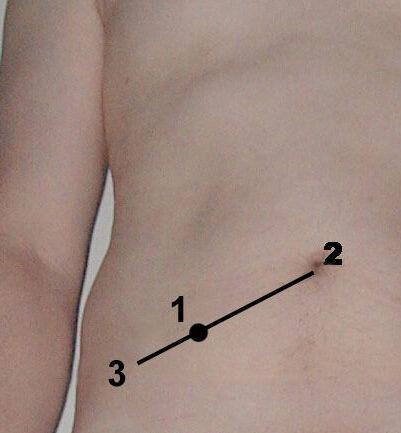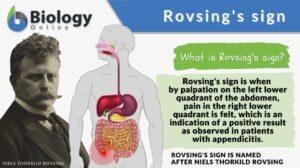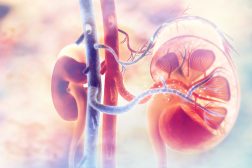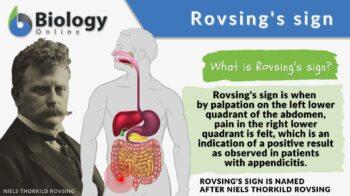
Rovsing’s sign
n., [rov-singz saɪn]
Definition: a sign of pain in the lower right side of the abdomen when doing palpation starting in the lower right abdomen, gliding up
Table of Contents
Rovsing’s Sign Definition
Rovsing’s sign is when palpation on the left lower quadrant of the abdomen results in pain in the right lower quadrant (at McBurney’s point). The indirect tenderness or pain felt by the patient is generally attributed to the pressure in the colon and the appendix caused by the pressure applied in the lower right abdomen (over the descending colon), gliding up. The sign is often used as an indication of appendicitis (inflammation of the appendix), named after Niels Thorkild Rovsing, a Danish surgeon.
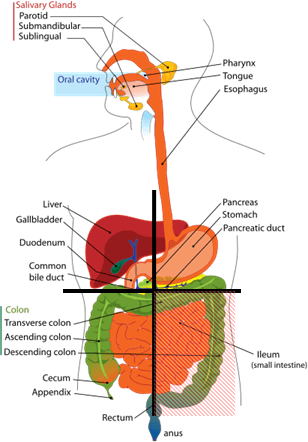 Four abdominal quadrants, showing organs in each quadrant: left lower quadrant (LLQ), left upper quadrant (LUQ), right upper quadrant (RUQ), and right lower quadrant (RLQ). When a patient with appendicitis is palpated in the LLQ, pain is experienced in the RLQ. |
|
More Info on Rovsing’s Sign
A positive Rovsing’s sign is when pain is felt at McBurney’s point when pressure is exerted over the descending colon. A similar sign though was first described by another surgeon, Emil Samuel Perman. (Cadogan & Cadogan, 2021)
Perman’s sign vs. Rovsing’s sign | |
|---|---|
| Perman’s sign | Rovsing’s sign |
|
|
|
|
| Demo: | Demo: |
| Note: many would refer to this maneuver for Rovsing’s sign but this is more related to what Perman described. (Prosenz & Hirtler, 2014) | Note: palpation is done by applying pressure on one hand while gliding up with the other hand |
Rovsing’s Sign and Appendicitis
The appendix vermiformis — or simply, appendix — is a narrow tube that extends off the cecum and is located in the right lower quadrant of the abdomen. When inflamed (swollen), the condition is referred to as appendicitis.
In the early course of the disease, the patient may experience a sudden, sharp pain that may feel like a cramp near the navel. The pain, then, shifts to the lower right abdomen indicating that the parietal peritoneum is possibly affected. The pain often gets worse over time; worst, when the appendix has burst.
Appendicitis is a medical emergency and so must be seen by a medical professional right away.
The clinician might do the maneuver during an abdominal examination to test for Rovsing’s sign (or Perman’s sign). Pressure is applied in the left lower quadrant of the abdomen of the patient suspected of appendicitis. This is to increase the pressure in the colon and the appendix.
Pain on the side opposite to where the pressure is applied is an indication of a positive sign. This indirect localization of tenderness or pain provides a rather objective and more reliable indication of the pain condition. This is then followed up with more definitive diagnostic tests, such as abdominal CT or ultrasound.
Quiz yourself!
References
- “Appendix pain”. (2017). Ada.com. https://ada.com/conditions/appendix-pain/
- Cadogan, M., & Cadogan, M. (2021, May 30). Niels Thorkild Rovsing. Life in the Fast Lane • LITFL. https://litfl.com/niels-thorkild-rovsing/
- Herdon, A. (2021, March 16). Rovsing’s sign: what is it, and how it helps your clinical diagnosis? InSimu. https://www.insimu.com/2021/03/16/rovsings-sign-what-is-it-and-how-it-helps-your-clinical-diagnosis/
- Perman, ES (1904). “Om indikationerna för operation vid appendicit samt redogörelse for å Sabbatsbergs sjukhus opererade fall” [About the indications for surgery in appendicitis and an account of cases at Sabbatsberg Hospital]. Hygiea. 66 (2): 797–847.
- Prosenz, J., & Hirtler, L. (2014). Rovsing Sign Revisited—Effects of an Erroneous Translation on Medical Teaching and Research. Journal of Surgical Education, 71(5), 738–742. https://doi.org/10.1016/j.jsurg.2014.03.002
- Rovsing T. Indirektes Hervorrufen des typischen Schmerzes an McBurney’s Punkt. Ein Beitrag zur Diagnostik der Appendicitis und Typhlitis [Indirect elicitation of the typical pain at McBurney’s point. A contribution to the diagnosis of appendicitis and typhlitis]. Zentralblatt für Chirurgie 1907 ;34: 1257-59
©BiologyOnline.com. Content provided and moderated by Biology Online Editors.
